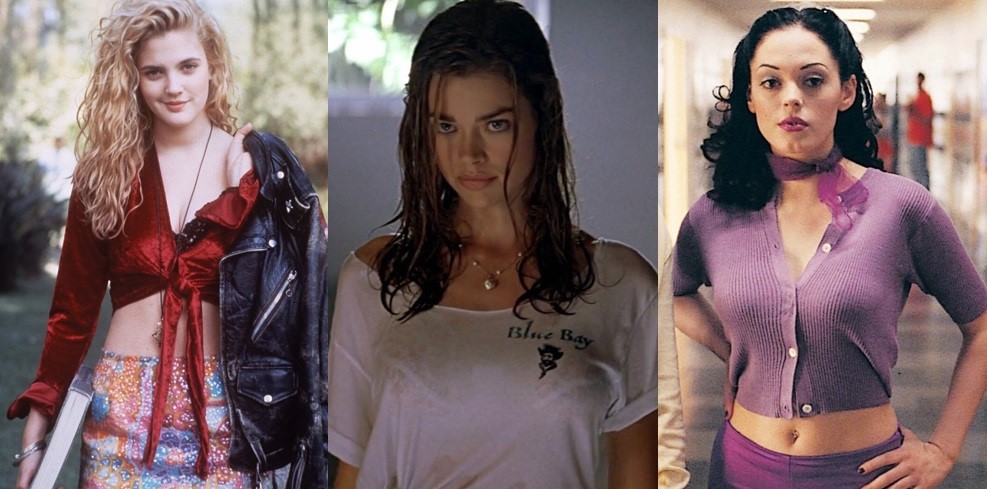In the mid-’90s, when I became both a movie fan and a teenage girl, I noticed something strange. At 13, I perceived myself as a hopeless dork, someone who still cried while watching “The Lion King,” and was probably going to die of old age before I was able to make eye contact with a boy. But according to a steady stream of films that showed up on the “new releases” shelf at my video store, I was also capable of murder.
Just a few years earlier, the most antisocial thing a teenage girl in a mainstream movie could do was make out with John Bender. Starting with 1989’s “Heathers,” films began to suggest that we might be capable of darker acts: killing a friend’s mom so that we could hook up with her dad (1992’s “Poison Ivy”), killing a friend’s mom so said friend doesn’t move away (1994’s “Heavenly Creatures”), or killing college classmates for a wide variety of half-baked reasons (1998’s “Urban Legend”). Throughout the ’90s, girls committed murders in movies both indie (1994’s “Fun”) and mainstream (1998’s “Wild Things”), dramatic (1992’s “The Crush”) and comedic (1999’s “Jawbreaker”). And that’s not even counting movies where girls tried really hard to kill but failed (1994’s “The Professional”), killed but had a pretty good reason for it (1992’s “Gun Crazy”), or killed as part of a deranged cross-country murder spree with their equally psychotic spouse (1994’s “Natural Born Killers”). And you didn’t have to go to your nearest college town art house to see these—suburban cineplexes regularly served up movies about beautiful girls driven to do terrible things.
And then, almost as abruptly as it started, it stopped. 1999’s “Jawbreaker” was the last major mainstream “girls who kill” flick of that era, by my count; future entries in the canon, like 2000’s “Ginger Snaps,” seemed to exist only within the deepest reaches of your local Blockbuster.
Every generation has its “women in trouble” cinema, from the classic noir of the ’40s to the exploitation cinema of the ’70s. The early ’80s even saw a wave of films specifically about teenage female angst, like 1980’s “Foxes” and “Times Square,” and 1982’s “Ladies and Gentlemen, The Fabulous Stains.” However, while the ‘90s “girls who kill” trend shares threads with all of these waves that came before it, it also stands apart in its focus on youth and violence—never before did so many films make the case that girls too young to get into an R-rated movie might be prone to solving their problems with guns, knives, or a lethally large piece of candy.
So what exactly was happening in the ’90s mania for girls who kill? Why did it start? Why did it stop so abruptly? And, in this moment of broad cultural reevaluation of the ’90s, what does it all mean?

When looking at the inception of this mini-genre, its obvious roots are in rebellion against the Reagan-era teen films that immediately proceeded it. “Heathers,” says critic Abbey Bender, “feels like a darkly comic rebuke to the more ‘wholesome’ John Hughes movies so associated with the ’80s.” And once that Pandora’s box was opened, “things started to gradually get darker from there, especially with teen nihilism becoming a big cultural theme in the early ’90s with grunge.”
“Heathers” is obviously the first example of the genre chronologically, but it is not quite the most instructive: Winona Ryder’s Veronica may kill her high school frenemies, but only because she was tricked by Christian Slater’s genuinely psychopathic J.D. For a more representative example of the kind of willingly murderous girl we’d spend the next decade with, we have to fast forward to 1992’s “Poison Ivy.”
Though many people assume that “Poison Ivy” was based on the 1992 case of teenage attempted murderer Amy Fisher, the film actually predates Fisher’s crime. Rather, director Katt Shea says the character of Ivy was inspired by a real-life person who upended the life of one of the film’s producers (though, she is quick to point out, that Ivy didn’t kill anyone; she was just trying to get a leg up in the film industry). Closer to an ’80s neo-noir or erotic thriller than a movie starring Molly Ringwald, “Poison Ivy” chronicles the life of a troubled upper-class Los Angeles family, who watch their lives fall apart after taking in a sexy and charismatic teenage drifter named Ivy (Drew Barrymore). Charming, disturbed, and desperately lonely, Ivy becomes involved in an (illegal) sexual relationship with the family’s father, plays mind games with the daughter, and eventually pushes the mother off a balcony to her death, before going the same way herself in the film’s climax.
And yet, there’s no denying that Ivy is the movie’s heart, a character who is almost impossible not to empathize with—like the heroines of film noir, she’s magnetic, her story exists largely in gray areas of motivation and morality, and because of all of this, her crimes feel almost understandable. “I wanted Ivy to be somebody that you could relate to,” says Shea. “She wanted a family, she wanted to belong. It’s all these things that anybody can identify with. She just went about it the wrong way.”

But perhaps Ivy is most memorable because her character is a brutally frank depiction of how little power teenage girls actually have, and how easy it is to mistake your sexuality for strength in that environment. “There’s this powerlessness that we feel as young women,” says Shea. Ivy tries to use her sexuality to achieve her goals without really understanding what she’s doing or why she’s doing it, but “it feels like power,” says Shea. “And when you’re a [teen] girl, you’ll take any kind of power you can get.”
Ivy and her messy, relatable motivations served as a template for many of the heroines that followed, while the success of “Poison Ivy,” which played Sundance and the Museum of Modern Art, opened the door for similar films. But the entire genre isn’t simply a case of copycat filmmaking. From the Amy Fisher case to Tonya Harding and OJ Simpson, ’90s popular culture was notable for its obsession with crime and violence. In the early ’90s, says Kate Hagen, director of community at the Black List, popular media was obsessed with the idea that cities were overrun by crime “and all of that sort of hysteria around the decline of America.” These films were, in some ways, “just the sort of natural tabloid extension of a lot of that thinking—that even our daughters are going to become murderous.”
The films were also buoyed by feminism’s increasing profile in the decade’s popular culture. In an era that saw the improbable mainstream success of transgressive female musicians like Courtney Love and Liz Phair, examination of women’s emotions that were once taboo was now seen as reasonable and empowering—and even profitable.
But were the films actually empowering? On paper, movies about sexy teenage girl murderers sound like a sexist mess. But in execution (pun intended), the best of these films were about subverting preconceptions. Many of these films, says Bender, “wink at the fact that teen girls have always been simultaneously hated on and lusted after by the mainstream viewer, who is by and large presumed to be the typical heterosexual white man. So in many cases, these films play to this desire to see ‘hot’ ‘bad’ teen girls, but they subvert it by showing they are capable of violence.” And when it comes to teen female viewers, notes Bender, “I do think, given all the cool and charismatic girls in this genre, no matter how bad they are and what crimes they commit, there is still often some level of emotional connection and identification to be made by female viewers.”
This, Hagen points out, makes a clear connection to a previous genre about women who “snapped”: “I think a lot of women have not had those characters since the forties or the fifties, with film noir,” characters that allow the viewer to say “’Oh, she’s bad. But I love her.’” Though ‘90s teens often killed over friendship, while ‘40s femme fatales usually killed for love or money, both trends depicted women who transgress in a sympathetic light, giving the viewer room to examine their own transgressive feelings, using over-the-top violence as a metaphor to examine jealousy, rage, and other emotions women are largely expected to repress. “Some of these [‘90s teen] characters, I think, are sort of radical and can fit in more of those transgressive feminist modes,” says Hagen. Most viewers don’t identify with Heathers”‘ Veronica Sawyer because they think it’s cool to commit murder; she’s beloved because she offers a transgressive dramatization of the social pressures teen girls live with. We look at her and think, Hagen says, that “it’s hard being the good girl all the time.”

However, some of these films are exactly as gross and sexist as you’d think a film about a sexy teenage girl murderer would be. In films like “The Crush” or “Wild Things” (or even, to a lesser extent, “Jawbreaker”), teenage girls are evil, one-dimensional vixens who claim adult men as their victims—and to pull that off, notes critic Leila Latif, “you actually have to make the 16-year-old girl a full-on Hannibal Lecter sociopath.” Rather than reading as explorations of the darkness and gray areas of female adolescence, the characters in these particular films, says Latif, “always feel like male fantasies to me … And I wonder whether there’s a slight self-reassurance about, ‘We [adult men are] not the bad guys.’”
And it’s impossible to ignore the fact that at the same time that Hollywood was having an improbable romance with the idea of pretty white girls getting away with murder, the American news media often depicted teens of color as dangerous and “super predators.” This fixation had real-world consequences, leading to a more draconian juvenile justice system in the U.S., where more teens were being sent to adult prisons and given automatic minimum sentences. The idea of white girls committing violence was seen as sexy or exciting at the movies, but teens of color acting imperfectly in any way was often depicted on the nightly news as the downfall of society.
While there’s plenty of room to argue whether the films were empowering or demeaning, it’s a clear fact that by the turn of the century, the genre was finished. The reasons for this are myriad: Hagen points to larger cultural changes after 9/11 and cultural exhaustion with the darker teen culture of the ’90s; Latif notes that in the aughts, there was “a real pop culture puritanism that came in,” ringing in an era that obsessively and publicly policed young women’s sexuality. Bender links it to the rise of the internet, which meant that “audiences no longer had to seek out trashy movies in the hopes of titillation but could now access it easily online,” as well as to the 1999 Columbine massacre—“The idea of murderous teens became less of an escapist fun thing once school shootings became such a tragic reality.” Teen cinema tilted toward fratty comedies, which, ironically, seemed to have a bleaker view of women than any girl-with-a-gun film ever could. You tell me which movie thinks less of women: “Heavenly Creatures” or “American Pie”?

But like every trend, the teen girl killer genre is cyclical. And while echoes of the transgressive antiheroines of this genre can be felt in shows like HBO’s “Euphoria,” there have also been a few full-on films about teen girl murderers in recent years, like the 2015 Anya Taylor-Joy vehicle “The Witch,” the 2017 Anya Taylor-Joy vehicle “Thoroughbreds,” the 2017 dark comedy “Tragedy Girls,” the 2020 horror comedy “Freaky,” and the 2021 Anya Taylor-Joy vehicle “Last Night in Soho” (if anyone in Anya Taylor-Joy’s camp is reading this: can you ask her if she’s seen “Poison Ivy”? Just curious). But it has perhaps seen its fullest expression in this year’s Showtime series “Yellowjackets,” which not only examines the lifelong fallout from a violent incident among teen girls in the ’90s, but stars two of the brightest lights of ’90s Murder Girl Cinema: “Natural Born Killers” star Juliette Lewis and “Heavenly Creatures” star Melanie Lynskey.
And many of the films from the original wave remain popular with a new generation: “Heathers” became a hit musical in 2014, “The Craft” got a sequel in 2020, and “Poison Ivy” (which had been the subject of multiple sequels through the ’90s) helped inspire the 2017 SZA song “Drew Barrymore.” SZA later told Rolling Stone of the film’s protagonist, “She really just wanted to be loved. She was lashing out because she was lonely and pissed that her life was like this. I felt that.” Shea has moved on to directing other genres—her newest film, the rescue dog drama “Rescued by Ruby,” premieres on Netflix March 17—but young women still frequently tell her they love the character of Ivy. It disturbs Shea that so many teenage girls tell her they see Ivy—a character who was created to be an exploration of transgression, pain, and emotional gray areas, not a role model—as a hero. But she understands why people are still moved by her film, and films like it, 30 years later. “It’s not that different today [than it was in 1992]. I would love to pretend that everything is all better and women are equal and all that stuff. It’s not true,” says Shea. “Do young women feel powerless, and ignored, and left behind? Absolutely.”











